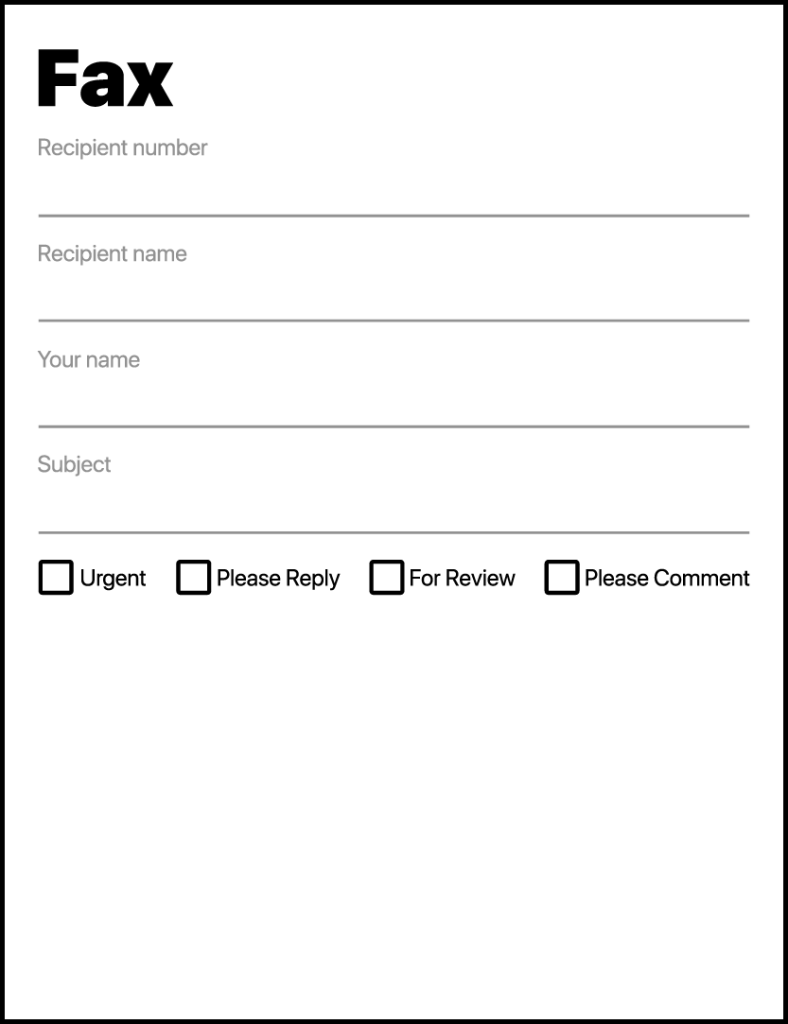Fax Cover Sheet vs. Fax Header: However, when dealing with faxed documents, two terms often confuse users: fax cover sheet and fax header. These two components serve different purposes, and understanding their roles is crucial for professional, legal, and secure fax communication.
Fax Cover Sheet vs. Fax Header: What’s the Difference?
Faxing, though considered a legacy communication tool by some, still holds significant importance in many industries such as healthcare, legal, finance, and government. While the digital era has introduced modern alternatives like email and secure file transfers, faxing remains valued for its security, compliance, and direct document transmission.
- How to Send Faxes From An iPad
- Basic Fax Cover Sheet
- Professional Fax Cover Sheet
- Confidential Fax Cover Sheet
- Personal Fax Cover Sheet
- Fax Filing Cover Sheet
- Modern Fax Cover Sheet
What Is a Fax Cover Sheet?
A fax cover sheet is a separate document that is typically sent as the first page of a fax transmission. Its primary function is to introduce the faxed material and provide essential details about the sender and recipient.
This is especially important when a fax is going through multiple departments, recipients, or offices. The cover sheet ensures the correct recipient receives the document and understands the context of the transmission.
Common Elements of a Fax Cover Sheet:
- Sender’s Information: Name, title, company, phone number, fax number, and email address.
- Recipient’s Information: Name, title, department, company, phone, and fax number.
- Date and Time of Transmission
- Number of Pages (Including the Cover Sheet)
- Subject or Reference
- Comments or Notes (Optional): This might include instructions like “For your review” or “Confidential.”
- Confidentiality Notice: A legal disclaimer about unintended recipients and data protection.
Purpose and Benefits:
- Identification
- Professionalism: Demonstrates organized and thoughtful communication.
- Security: Alerts handlers and recipients if the document contains sensitive or confidential data.
- Routing: Helps the recipient’s office route the fax to the correct person or department.
- Audit and Recordkeeping: Adds a formal record to help track communications.
What Is a Fax Header?
Also known as a Transmission Header or TSI (Transmitting Subscriber Identification), the header contains technical details about the fax transmission.
Common Elements of a Fax Header:
- Sender’s Fax Number or Name (TSID): This may appear as a phone number or organization name.
- Date and Time of Transmission
- Page Numbering (e.g., “Page 1 of 5”)
- Receiving Fax Number (in some cases)
Some systems allow users to customize the content of the header.
Purpose and Benefits:
- Authentication
- Timestamping: Shows when the document was transmitted.
- Pagination: Useful for checking if all pages were received.
- Technical Traceability: Helps track fax transmission history, especially in regulated environments.
Key Differences Between a Fax Cover Sheet and a Fax Header
| Aspect | Fax Cover Sheet | Fax Header |
|---|---|---|
| Location | First page of the fax document | The top margin of every page |
| Created By | Manually by the sender or template | Automatically by the fax machine/system |
| Purpose | Communicate context and instructions | Provide transmission metadata |
| Customization | Highly customizable | Limited to system configuration |
| Information Provided | Sender/receiver info, subject, notes, confidentiality | Date, time, fax number, page number |
| Visibility | Fully visible as a complete page | Visible as a single line at the top of each page |
| Formality | Part of formal documentation | Considered technical metadata |
Use Cases Where Both Are Important
In industries that require detailed documentation for compliance, such as healthcare (under HIPAA) or finance (under Sarbanes-Oxley), both the fax cover sheet and fax header play vital roles:
- Healthcare: A fax cover sheet might declare a document as confidential medical information, while the header shows when and from where it was sent.
- Legal: Attorneys often use cover sheets to declare privilege or provide a case reference. The fax header can provide proof of when documents were submitted.
- Government: Government offices use headers and cover sheets to track communication between departments or agencies.
Are They Mandatory?
A fax header is often automatically generated and not something users think about. However, many institutions require it for compliance, tracking, or dispute resolution.
Fax cover sheets, while not legally mandatory in every situation, are widely considered a best practice, especially when handling confidential, sensitive, or formal communication. Many organizations require their inclusion as part of the standard operating procedure.
Digital Faxing and the Evolution of Headers and Covers
With the rise of internet faxing and digital fax platforms (like eFax, HelloFax, or SRFax), fax cover sheets are often automatically generated through templates, and headers are included in metadata or formatted PDF overlays.
Some platforms allow you to upload your cover sheet or remove the auto-generated header if needed. However, when compliance or documentation is required, disabling headers can be risky.
Conclusion
While both fax cover sheets and fax headers are small components of a fax transmission, they serve significantly different but equally important roles. The header, on the other hand, is technical metadata, offering traceability, timestamps, and authenticity for both users and systems.
Understanding and using both properly ensures secure, professional, and compliant fax communications. Whether you’re working in a hospital, a legal office, or a corporate environment, mastering the distinction between these two elements helps protect data integrity, maintain clear communication, and support document tracking across departments.
